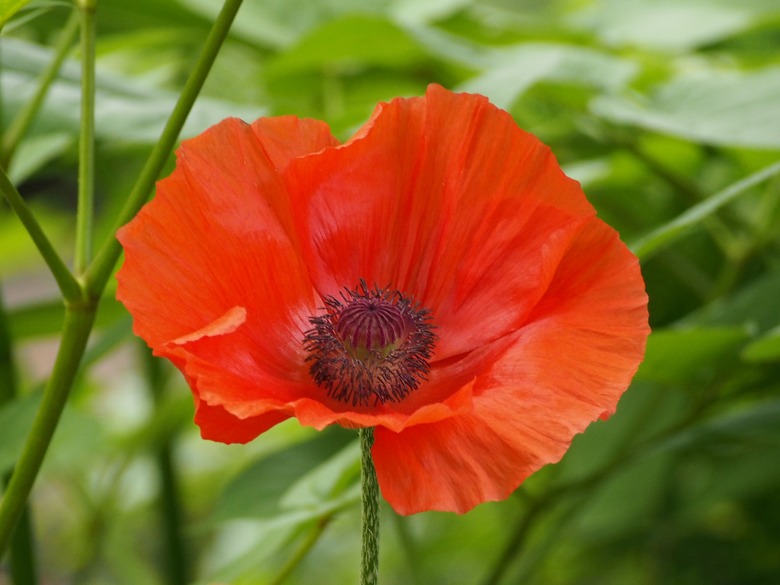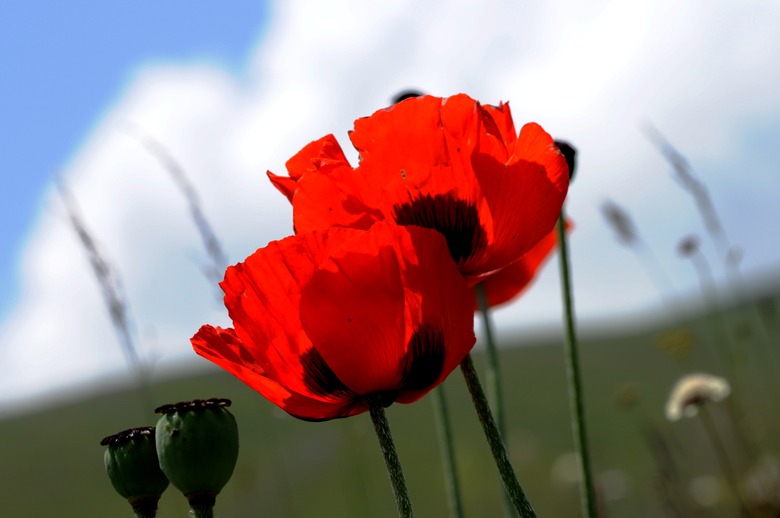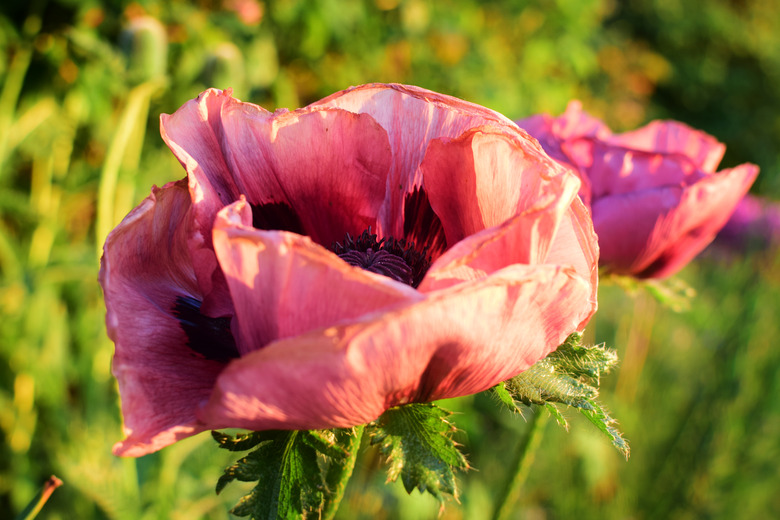How To Prune Oriental Poppies
Where Do Oriental Poppies Grow Best?
Oriental poppies (Papaver orientale), the big, bold and showy flowers with multiple petals resembling crepe paper, were the first members of the poppy species to be cultivated in European gardens. This plant, a perennial in USDA plant hardiness zones 3 through 7, is one of only three poppy species that have been used to create the modern-day poppy hybrids.
In its native range across the Western Asian regions of Iran, Northern TurkeyCannd the Caucasus, it flourishes when wet and cold pervade the winter and hot and dry weather take over in the summers. Here in the U.S., however, we have different soil profiles than these native ranges, so gardeners must be careful not to grow Oriental poppies on poorly draining soil that retains water. Otherwise, plants may succumb to fungal diseases that proliferate in soggy soil.
Poppy Plants and Opium
Confusion reigns regarding poppy plants, as general thought considers them purveyors of opium, and their poppy seeds yield positive results when drug testing. The different species of poppies resemble each other, leading to the confusion, but the Oriental poppy does not produce the chemicals that give us opium, much to the chagrin of Queen Victoria, who built her empire on the opium poppy trade.
Characteristics of the Perennial Oriental Poppy
**Leaves and Flowers:** The Oriental poppy has two types of leaves. The first type grows on the tall stems and are finely divided, which gives plants an airy look in the landscape.
The flowers, which are up 6 inches in diameter, are also borne on tall stems and attract bees, butterflies, and hummingbirds in late spring to early summer during this plant's blooming period. After flowering, the 2- to 3-foot-tall Oriental poppy plants die to the ground.
This is when the second type of leaves appear as a basal rosette that hugs the ground. These leaves resemble the leaves of thistles. When pruning, removing the basal rosettes may weaken or even kill the Oriental poppy.
**Flower Colors:** Flower colors include red, orange, pink, lavender, purple, burgundy, or white. Flowers typically have darker blotches at the base of each petal, which are a darker shade that the petal color.
**Heat and Humidity Issues:** Even though its perennial range extends to zone 7, Oriental poppy struggles in the heat and humidity of zone 7 and other climates, so growing this species as a perennial may present a bit of a challenge in these areas.
**Perennial Types:** The different types of poppies that fall into the perennial classification are the Oriental poppy; the Iceland poppy (Papaver nudaucaule), which thrives in zones 2 to 8; or the Alpine poppy (Papaver alpinum), which is grown in zones 4 to 6.
They are unlike the glorified annual poppy varieties, such as the field poppy (Papaver rhoeas), also known as the Flanders poppy, that is symbolic of World War I losses or the California poppy (Eschscholzia californica), which pervades the United States and is known to sprout almost yearly, like a perennial.
Routine Maintenance of the Oriental Poppy
Removing the spent poppy flowers and cutting back the tall foliage are the only maintenance tasks perennial poppies require.
Depending on your taste in garden appearances, you can keep your garden crisp and clean by cutting back the foliage or letting it naturally die back after the plants finish flowering. Neither will affect the blooming habit of the Oriental poppy. However, winter protection is afforded by lightly applying mulch around the poppies.
Poppy Blooming Season and Deadheading
The blooming season of the Oriental poppy is short. If you blink between late spring and early summer, you've missed the glorious floral display for which they are famous.
Deadheading the spent flowers prevents seed formation, but the window to deadhead is short. Watch for the flowers to fade and crumple and then remove the flower head. Hold the flower head in the cup of your hand and snip at the base.
Avoid Dropping Spent Flowers on the Ground
Discard the spent flowers without dropping them on the ground around plants, because they may contain eggs (or egg cases) of various pests. When the eggs hatch, the larvae typically burrow into the ground around plants and feed on the roots, which can weaken or kill plants.
When the larvae pupate, they'll overwinter in the soil during winter and emerge in springtime as adults that feed on the flowers and start the egg-laying cycle all over again. One example is the hoplia beetle (Hoplia callipyge), a pest of Oriental poppies.
When to Start Deadheading
Deadheading prolongs the blooming season for your poppies, and a close eye on the blooms prevents seed formation. As soon as the flowers fade, they need to be deadheaded, but some gardeners prefer to leave the seedheads in order to enhance the look of the garden.
In the fall, when the poppy plant is fully spent except for the basal rosette of leaves that may persist through winter in warm climates, remove all the flower debris to prevent a fungus or mildew from invading your garden and spending the winter just below ground. It will rear its head again in the spring, and your Oriental poppies will need applications of fungicide.
Retaining the Seedhead and Trimming
Some gardeners prefer to keep the seedheads of the poppy as food for wild animals during the winter. The seeds self-sow by falling to produce new poppies in the spring. The seedheads are also attractive.
Trimming, or thinning, is also a maintenance task that will promote the growth of the Oriental poppy. They are thinned for several reasons: to reduce the risk of disease, to increase the flower size or to create a poppy that is more attractive.
Trimming is also necessary to remove damaged or diseased stems. A snip of the stem at the base of the poppy easily improves the air circulation around the plant, thus reducing the risk of disease.
Tip
As soon as the flowers fade, they need to be deadheaded—though some gardeners prefer to leave the seedheads in order to enhance the look of the garden or provide food for wild animals during the winter
Dividing Oriental Poppies
Clumps of Oriental poppies can be divided to promote better growth by freeing up root space and improving their absorption of water and nutrients. You'll also expand the size of your poppy garden by adding more plants.
Divide Oriental poppies in the fall when flowering is over. Choose a cloudy, overcast day to avoid the strain of the sun's heat and be sure to water the soil the previous day to make extraction easier and prevent the plant from drying out.
Dig up the parent plant and with your hands, gently separate the roots into smaller clumps. Remove the loose dirt attached to the roots. Divide until you have about five shoots and their accompanying roots. Keep them moist and replant, making sure that freezing temperatures are still weeks away.
Planting season for Oriental poppies begins in the fall just before the first freeze, and they bloom the next spring. Be sure they receive full sun and that they are located in well-draining soil that doesn't collect water and thus result in root rot. Oriental poppies lose their vertical foliage in late summer, and it is suggested that other flowering plants be situated as companions to fill in the vacancies when the perennial poppies rid themselves of their spent blooms.
References
- North Carolina State Extension: Papaver orientale
- University of California IPM: Poppy – Papaver Spp.
- Colorado State University: Perennials: Maintaining
- Purdue University: Indiana Yard and Garden: Question and Answer
- University of Minnesota Extension: How and When to Divide Perennials
- University of California IPM: Hoplia Beetle


